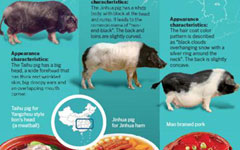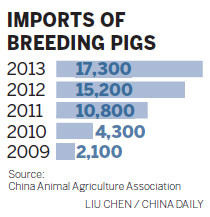Bringing home the bacon
Updated: 2014-05-06 15:00
By Zhong Nan (China Daily)
|
|||||||||||
This has forced China to maintain a cultivation scale of 50 million sows per year to ensure pork supply and demand are in balance, according to a report by the college of animal sciences and technology at Wuhan-based Huazhong Agricultural University.
"Based on this figure, such a low cultivation rate can waste 20 million metric tons of grain-based feed in China every year. The wasted grain is equal to one year's basic rations for 75 million Chinese residents," said Wang.
|
 |
|
 |
Chen Jie, a researcher at the research center for the rural economy of the Ministry of Agriculture, said the diet structure of foreign breeding pigs is heavily based on large-scale feeding systems and high-protein feed made from corn, soybean and fishmeal. They cannot get used to the dispersed feeding method that includes corn-based starch and roughage feed and excessive use of additives conducted by Chinese pig farmers within a short period.
"Chinese pig keepers must be aware that imported breeding pigs are only capable of raising infertile offspring and producing processing meat. They have to purchase a large amount of costly high-protein grain feed every day to run their businesses," Chen said. "Another fact they should realize is China's grain prices have remained high in recent years while the government is trying hard to ensure its grain security."
China's pork production amounted to 54.93 million tons in 2013, a 2.8 percent rise from a year earlier, data from the National Bureau of Statistics shows. It makes it the world's biggest pork producer and consumer. To tackle food inflation, the nation's pork imports totaled 584,000 metric tons last year, a notable 12 percent increase from 2012.

Yu Chuanzhou, a professor at Huazhong Agricultural University, said Chinese native pigs are gradually disappearing. Native species account for around 10 percent of the 50 million sows in China.
The research work by the Ministry of Agriculture survey from 2004 to 2008 discovered four breeds, including the Shenxian in Hebei province and the Xiangcheng in Henan province, have already disappeared.
To avoid extinction and develop native species, the Chinese government has placed 34 species under State-level protection, which means they cannot be slaughtered.
The red-hot domestic pork trading market has also driven capable Chinese companies to secure pork supplies from the global market, Chinese pork producer Shuanghui International Holdings Ltd, a subsidiary of Luohe-based Shuanghui Group, completed a $4.7 billion purchase of US pork giant Smithfield Foods Inc last year, the largest Chinese acquisition of a US company.
Related Stories
Domestic pig breeds at risk of dying out 2013-07-08 07:12
China's pork price rebounds after government boost 2013-05-23 09:54
46 jailed for selling meat from sick pigs 2013-03-14 02:59
Chinese pork firm launched $5.3b IPO in Hong Kong 2014-04-10 16:24
China announces pork purchase scheme 2014-02-19 20:36
Smithfield to boost exports to China 2013-10-11 07:47
Today's Top News
Ukraine moves special forces to Odessa
Slovenian PM resigns
Disclosure of military secrets becoming bigger risk
China, AU to deepen co-op
UN hosts China Shanxi Food Festival
Chinese Parents: For some, it's 'Harvard, Harvard'
Japanese writer Junichi Watanabe dies at 80
Vietnamese veteran reminisces victory in the Battle of Dien Bien Phu
Hot Topics
Lunar probe , China growth forecasts, Emission rules get tougher, China seen through 'colored lens', International board,
Editor's Picks

|

|

|

|

|

|





